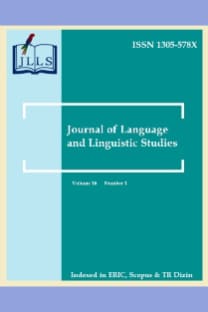The common european framework of reference for languages: İnsights for language testing
Avrupa dilleri öğretimi ortak çerçeve programı ve yabancı dil öğretiminde ölçmeye dair görüşler
___
- Alderson, J. C. (2002). Common European Framework of Reference for Languages: Learning, teaching, assessment. Strasbourg: Council of Europe.
- Alderson, J. C., Figueras, N., Kuijper, H., Nold, G., Takala, S., & Tardieu, C. (2004). The development of specifications for item development and classification within the Common European Framework of Reference for Languages: Learning, teaching, assessment. Reading and listening. Final report of the Dutch CEF construct project. Unpublished document.
- Alderson, J. C., Figueras, N., Kuijper, H., Nold, G., Takala, S., & Tardieu, C. (2006). Analysing tests of reading and listening in relation to the Common European Framework of Reference: The experience of the Dutch CEFR construct project. Language Assessment Quarterly, 3(1), 3-30.
- Alderson, C. J. (2007). The CEFR and the need for more research. The Modern Language Journal, 91(4), 659-663.
- Bachman, L. F. (1990). Fundamental considerations in language testing. Oxford: Oxford University Press.
- Bechger,T. , M., Kuijper, H., & Maris, G. (2009). Standard setting in relation to the common European framework of reference for languages: The case of the state examination of Dutch as a second language. Language Assessment Quarterly, 6(2), 126-150.
- Council of Europe. (2001). Common European Framework of Reference for language learning and teaching. Cambridge, UK: Cambridge University Press.
- Council of Europe. (2003). Relating Language Examinations to the Common European Framework of Reference for Languages: Learning, teaching, assessment. Strasbourg: Council of Europe.
- Council of Europe (2009). Manual for relating language examinations to the Common European Framework of Reference for Languages (CEFR). Strasbourg, France: Council of Europe. Retrieved from http://www.coe.int/t/dg4/linguistic/Manuel1_EN.asp
- Figueras, N., North, B., Takala, S., Verhelst, N., & Van Avermaet, P. (2005). Relating examinations to the Common European Framework: A manual. Language Testing, 22, 262-279.
- Fulcher, G. (2004). Deluded by artifices? The Common European Framework and harmonization. Language Assessment Quarterly, 1(4), 253-26.
- Harsch, C. & Rupp, A. A. (2011): Designing and scaling level- specific writing tasks in alignment with the CEFR: A test-centered approach. Language Assessment Quarterly, 8(1), 1-33.
- Huhta, A., Luoma, S., Oscarson, M., Sajavaara, K., Takala, S. & Teasdale, A. (2002). DIALANG: A diagnostic language assessment system for learners. In J. C. Alderson (Ed.), Common European framework of reference for languages: Learning, teaching, assessment. Case studies (pp. 130- 145). Strasbourg: Council of Europe.
- Jones, N. (2002). Relating the ALTE framework to the Common European Framework of Reference.
- In J. C. Alderson (Ed.), Common European Framework of Reference for Languages: Learning, teaching, assessment. Case studies (pp. 167-183). Strasbourg: Council of Europe.
- Milanovic, M. (2002). Common European Framework of Reference for Languages: Learning, teaching, assessment: Language examining and test development. Strasbourg, France: Council of Europe.
- Morrow, K. (Ed.). (2004). Insights from the Common European Framework. Oxford: Oxford University Press.
- North, B. (2000a). The development of a common framework scale of language proficiency. New York: Peter Lang.
- North, B. (2000b). Linking language assessments: An example in a low stakes context. System 28, 555-577.
- North, B. (2002). A CEF-based self assessment tool for university entrance. In J. C. Alderson (Ed.), Common European Framework of Reference for Languages: Learning, teaching, assessment. Case studies (pp. 146-166). Strasbourg: Council of Europe.
- North, B. (2007). The CEFR illustrative descriptor scales. The Modern Language Journal, 91(4), 656- 659.
- Weir, C. J. (2005). Limitations of the Common European Framework for developing comparable examinations and tests. Language Testing, 22, 281-300.
- ISSN: 1305-578X
- Yayın Aralığı: 4
- Başlangıç: 2005
- Yayıncı: http://www.jlls.org
Manana Rusieshvili CARTLEDGEA, Halis GÖZPINAR
Mansoor TAVAKOLİ, Marzieh NEZAKAT-ALHOSSAİNİ
Foreign language learners' views on the importance of learning the target language pronunciation
Dysprosody in aphasia: An acoustic analysis evidence from palestinian arabic
Speaking anxiety among Turkish EFL learners: The case at a state university
Yabancılara Türkçe kelime öğretiminde market broşürlerinden yararlanma
Daniel GHAMARİAN, Khalil MOTALLEBZADEH, Mohammad Ali FATEMİ
A cross-sectional study of Iranian EFL learners' polite and impolite apologies
Seyyed Hatam TAMİMİ SA D, Mohammad MOHAMMADİ
Code-switching in EFL classrooms and the perceptions of the students and teachers
The common european framework of reference for languages: İnsights for language testing
